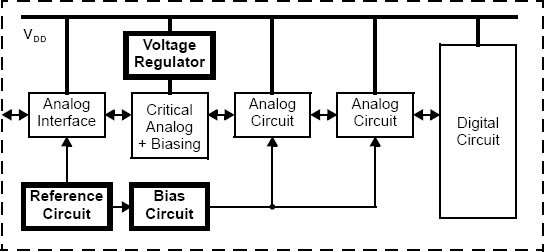
Although often ignored during the course of first-pass analog design, a critical factor in determining a circuit’s overall performance is the quality of the dc voltage and current sources. This chapter covers the design of circuits used to establish those dc voltages or currents. They are, themselves, sophisticated analog circuits usually employing feedback.
7.1 ANALOG INTEGRATED CIRCUIT BIASING
In an analog integrated circuit, many subcircuits work together to generate all of the various dc voltages and currents. These include bias circuits, reference circuits, and regulators. A bias circuit generates the dc voltages required to keep transistors near some desired operating point; of course, as transistor parameters change, either from chip to chip or with changes in temperature, so must the bias voltages. A reference circuit generates a voltage and/or current of a known fixed absolute value (for example, one volt). Finally, a regulator circuit improves the quality of a dc voltage or current, usually decreasing the noise. Fig. 7.1 shows how these circuits may work together to support the analog circuits on a large mixed analog–digital chip.

Fig. 7.1 A large mixed analog–digital integrated circuit emphasizing the role of biasing, references, and regulators.
7.1.1 Bias Circuits ...
Get Analog Integrated Circuit Design, 2nd Edition now with the O’Reilly learning platform.
O’Reilly members experience books, live events, courses curated by job role, and more from O’Reilly and nearly 200 top publishers.

